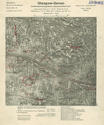 As with many ports in Britain, the years following the Great War saw a steady decline in the fortunes of Glasgow Harbour. By 1933 trade had slumped to just 5.3 million tons with the fall in coal exports being particularly severe. The expansionist development plans of the pre-war period were cut back as the cargo available reduced. Of the five great tidal basins proposed for land at Shieldhall only the King George V Dock was completed. Opened in 1931 this is now the last dock still in use in Glasgow Harbour.
As with many ports in Britain, the years following the Great War saw a steady decline in the fortunes of Glasgow Harbour. By 1933 trade had slumped to just 5.3 million tons with the fall in coal exports being particularly severe. The expansionist development plans of the pre-war period were cut back as the cargo available reduced. Of the five great tidal basins proposed for land at Shieldhall only the King George V Dock was completed. Opened in 1931 this is now the last dock still in use in Glasgow Harbour.
 But deepening of the river continued, mainly to satisfy the shipbuilders. This work allowed first the Queen Mary and then the Queen Elizabeth to reach the sea. On their way these vast ships floated in water 11.3 meters deep and sailed over places where a century and a half before the river could be crossed on foot. This achievement involved a vast amount of dredging, including blasting of an area of hard rock found near Renfrew.
But deepening of the river continued, mainly to satisfy the shipbuilders. This work allowed first the Queen Mary and then the Queen Elizabeth to reach the sea. On their way these vast ships floated in water 11.3 meters deep and sailed over places where a century and a half before the river could be crossed on foot. This achievement involved a vast amount of dredging, including blasting of an area of hard rock found near Renfrew.
 The deepened channel also had to be maintained as the flow from upstream carried sand and silt which settled in the artificially deep water. Maintenance dredging became an increasing burden for the Clyde Navigation Trust which was responsible for the river and harbour.
The deepened channel also had to be maintained as the flow from upstream carried sand and silt which settled in the artificially deep water. Maintenance dredging became an increasing burden for the Clyde Navigation Trust which was responsible for the river and harbour.
 The Second World War provided a major boost to the fortunes of the Clyde. Glasgow Harbour was relatively safe from attack and many millions of tons of shipping and cargo stretched the facilities to the limit. Shipbuilding and ship repairing also received a much needed invigoration and the ten or so shipyards within the Harbour were as busy as they had ever been. So too were the various dry-docks provided to assist in the repair of vessels.
The Second World War provided a major boost to the fortunes of the Clyde. Glasgow Harbour was relatively safe from attack and many millions of tons of shipping and cargo stretched the facilities to the limit. Shipbuilding and ship repairing also received a much needed invigoration and the ten or so shipyards within the Harbour were as busy as they had ever been. So too were the various dry-docks provided to assist in the repair of vessels.
 As confidence grew further plans were made for new developments. But changes in ships and trade that would mean the virtual end of Glasgow as a port were just around the corner.
As confidence grew further plans were made for new developments. But changes in ships and trade that would mean the virtual end of Glasgow as a port were just around the corner.